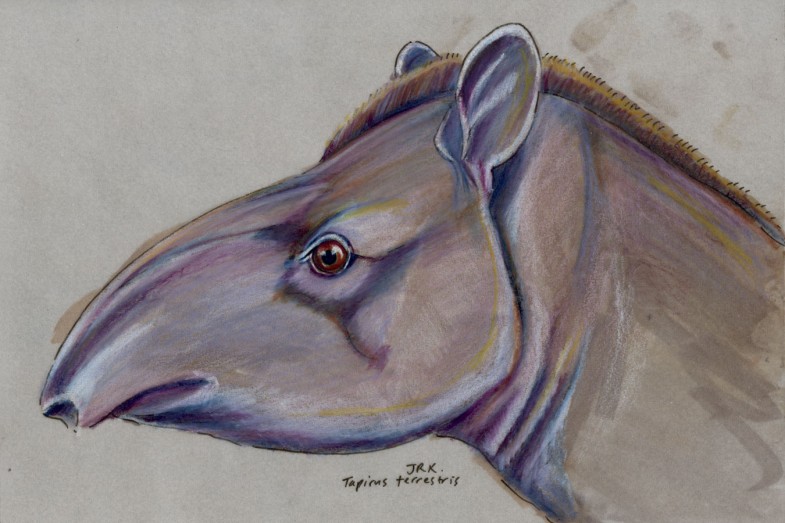Facebook Friends: Brazil: Brazilian Tapir (Tapirus terrestris)
I’m back from my perfect vacation to San Francisco. Now it’s time to continue our look at mammals from the 20 countries where people who like the Daily Mammal on Facebook live! Next up is Brazil and the Brazilian tapir (also called the South American or lowland tapir). Brazil has the second highest number of mammal species in the world, with 648, following Indonesia, which has 670. Though there are many mammals endemic to Brazil, the Brazilian tapir is not one of them. It lives not only in Brazil but also in several other countries of northern and central South America.
Tapirs are in the order Perissodactyla, which means “odd-toed,” and the animals in that order have an odd number of toes on each foot, except the tapir, sort of, which has three toes in the front but four in the back. Other perissodactyls are horses (one hoof, which I just read is essentially the middle finger, the others having vanished over millions of years of evolution) and rhinos (three toes on each foot). Tapirs are sometimes called “living fossils” because they are so similar to their primitive ancestors, who evolved 55 million years ago. They’ve changed less over the ages than the other perissodactyls have.
When they’re threatened, tapirs take to the water. Jaguars prey upon Brazilian tapirs, but the tapirs can sometimes dislodge the jaguars from their shoulders by submerging themselves in deep water. Adult Brazilian tapirs, who weigh 330–550 pounds, will kick jaguars and dogs that are attacking their young. That might not work on the anacondas and crocodiles that eat baby Brazilian tapirs whole, though. Brazilian tapirs use a variety of vocalizations for different purposes, such as identifying themselves, warning each other, or expressing pain. Unfortunately, hunters have found that they can lure the tapirs out by imitating these sounds. You can hear some tapir noises on the British Library’s website.
Tapirs also communicate through scent, using both urine and facial glands to mark with. When they smell each other’s urine, they exhibit the Flehmen response, which is a term new to me (and I love discovering new terms). It’s that face that you’ve probably seen horses and apparently cats make in which the animal curls its upper lip up, exposing its teeth and inhaling. They use it to help them detect pheromones.
Thanks to hunting, habitat destruction for agriculture, and its inability to quickly replenish its own population after it declines, the Brazilian tapir is vulnerable, and the IUCN rates it as such.


Beautiful drawing, Jennifer. As always.
I’m fascinated that it seems that the odd-toed hoofed animals really are closely related, so that they still belong in the same order. When animals were first categorized, as I understand it, they really had nothing much more to go on that grouping those that looked alike, or had similar features. Now, with DNA we can very precisely pinpoint the evolutionary branching points of so many species, and mammals seem to be reclassified all the time. It’s nice to see the old classifications, based on appearances and naturalists’ best guesses, sometimes still hold up.
Assuming, of course, that anyone’s really double-checked this order with DNA classification. We may wake up tomorrow to discover they’ve all been assigned other places on the tree of life.
Great points well put! One drawback of this project, which is becoming more clear the longer I go, is that I never get a very deep understanding of anything, but just a quick, intriguing introduction to a lot of things. From what I can glean, even though rhinoceroses and zebras seem pretty different, they do share a common ancestor, and I think that’s determined by genetic sequencing as well as comparing their anatomy and teeth and whatnot. Here’s a page on the American Museum of Natural History site that has a little more about it.
Thanks for this interesting post. Is there an order of odd-toed, non- hoofed mammals?
You’re welcome, Grace, and thank you! No, the other orders are grouped differently. Only the hoofed mammals get their toes counted. Here are all the orders and who’s in them, more or less—there’s some disagreement over how many and what they are.